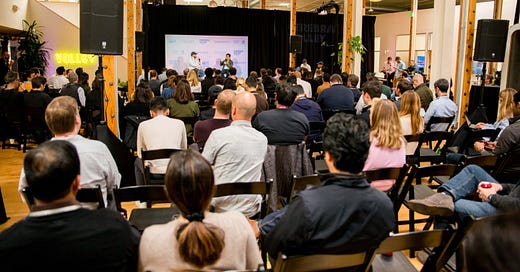What We Learned at the Cerebral Valley AI Summit: Early Takeaways and Photos
Cerebral Valley panelists debate the letter calling for a 'pause' in AI development. Watch Miles Grimshaw interview Adam D'Angelo & Harrison Chase
We wrapped up the Cerebral Valley AI Summit yesterday. I’m so grateful to everyone who helped out, spoke, attended, or wrote about the event. I couldn’t have imagined our first summit going better!
Thanks to the team at Volley for co-hosting Cerebral Valley with me — and for all their help and support.
Now, I’m eager to bring the conference to the newsletter through the magic of video and the written word.
You can view the first video from the conference now. Watch Benchmark’s Miles Grimshaw interview Quora’s Adam D’Angelo and LangChain’s Harrison Chase. (I pipe in from the audience with a spicy question at 23:30.)
I plan to share more of my thoughts from the conference next week but here are some takeaways with the help of Tomio Geron.
A huge thanks to sponsors Samsung Next, Oracle Cloud + NVIDIA, Greylock, Felicis, Lambda, Akash, Klarity, Alexa Fund, Richmond Global, Bain Capital Ventures, M12, Rackhouse, and SVB.
Shoutout to Volley’s Gaby Caliendo for the on-the-ground organizing and to my chief of staff Riley Konsella.
The Cerebral Valley AI Summit is presented by
Samsung Next invests in the boldest and most ambitious founders.
Tell us about your company. We’d love to meet.
Key Takeaways
We covered a lot of ground, from business models to larger philosophical debates to more practical issues of building AI companies.
Open vs Closed
There’s a brewing AI war between the closed foundation model companies, like OpenAI and Anthropic, and a constellation of open-source companies.
Clément Delangue, the founder of Hugging Face, argued that transparency in AI is essential for the public and regulators to understand how the systems work and to help mitigate their flaws and biases.
“Otherwise you end up with a world where these technologies are built behind closed doors,” he said. That “creates a narrative that’s completely disconnected from reality.”
Asked why he chose to build an open-source model, Databricks’ Ali Ghodsi said he wanted to make the technology accessible to others. “Do we want a world in which there’s five companies” that have these AI models? Ghodsi asked. “You want that to be in everybody’s hands.”
The Letter
Stability AI CEO Emad Mostaque signed the recent open letter calling for a six month pause in the development of AI.
On stage at the Cerebral Valley AI Summit he said that he signed the letter because more advanced AI models could be an “existential threat” to society and cause the “overturning [of] our democracy.”
He argued that some private foundation model companies are “completely opaque.”
“Let’s have an open discussion about transparency, governance, and sovereignty,” he said.
Meanwhile, the Databricks CEO Ali Ghodsi argued that it was too late to pause AI research.
“I think we’re all going to be 10 to 100 times more productive [with AI]. I think this stuff is going to be great for healthcare, housing, education,” Ghodsi said. “Also people who do bad, malicious things also will do that 10 to 100 times better.”
The answer to this problem is not to shut down AI but to develop AI tools to combat it, Ghodsi said. There will be other countries and people who won’t stop working on AI despite regulation—so we can’t abandon it, he said.
The Cerebral Valley AI Summit is sponsored by
Oracle is no newcomer to GPU infrastructure. We were first to launch NVIDIA A100s and we just unveiled H100 Superclusters.
The Industrial Revolution (or Practical) Era
While OpenAI is building deeper general AI models, Adept CEO David Luan, who was an early OpenAI employee, said his company is more focused on specific, practical use cases.









